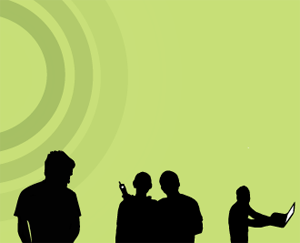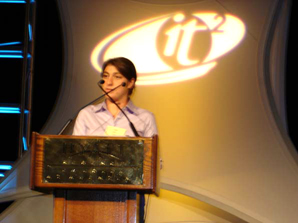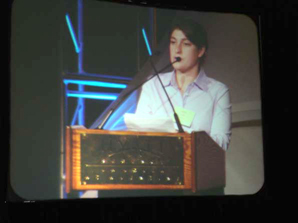Grad Fellow Jamie Link Discusses the Scientist's Role
|
11.02.04 - I entered the doctoral program in the Chemistry and Biochemistry department at UCSD in the fall of 2000. I arrived without a clear idea of what I wanted to study, and I joined Mike Sailor's lab because I was interested in chemical sensing. By the end of my first year, I was still trying to find my niche and decide on a thesis project. Two timely events in the fall of 2001 quickly shaped the direction of my thesis research and my course of study at UCSD. The first was September 11. The second was being chosen among the first class of graduate fellows at Calit².
The events of September 11 were a wake-up call for all of us, and we realized that our nation's security was being challenged in a way it had never been challenged before. The threat posed to our society was not a well-defined, unilateral threat that could be addressed by a few brilliant minds behind closed doors. This was an entirely new challenge to the nation's scientists that would require an unprecedented level of coordination among researchers (both in industry and academia), government officials, and first responders.
I considered myself in a position of extreme good fortune as a scientist because the government was subsequently eager to fund an area of research that was fundamentally interesting to me. Secondly, I found myself in a prime position to conduct this research within an organization where I would be collaborating directly with those interested in developing, commercializing, and deploying the technologies I was so eager to see implemented within society. Calit² was perfectly poised to assume a leadership role in this arena where sensor networks and the rapid distribution of information would be of critical importance.
|
During the three years that followed, I worked in this stimulating environment to develop chemical sensors that could be widely deployed for environmental surveillance applications. Through Calit², I was able to interact not only with other chemists, physicists, and biologists who were developing different sensors for the same types of applications, but also with the engineers who would work on linking all these sensors into a single package, with the scientists who would design the software systems and interfaces necessary for networking these packaged nodes, and with those who would be directly involved in deploying these sensornets within our communities.
My research took on a whole new, and much broader, perspective, and, through various Calit² events, I found myself listening to discussions among faculty regarding the formulation of policy recommendations on how best to implement our technologies within existing economic and political frameworks and about issues like the necessity for developing national and international technological standards. I was beginning to develop a feel for the broad scope of issues involved at the nexus of science, technology, and society.
And through all of these events, I learned the value of communicating both with scientists in different fields as well as with the general public during the early stages of research. For example, I was permitted to participate in events like the 2002 UCSD Homeland Security Media Briefing, an event that was intended to highlight the university's efforts in Homeland Security in the year since 9/11. The majority of the faculty speakers were associated with Calit², and the purpose of the event was to share information with the public regarding the efforts of the university that were being implemented in the community.
|
Especially for an area like Homeland Security, where the cooperation and trust of the public would be essential to responding to a threat or an attack, I realized that the timely dissemination of scientifically accurate information to the public was essential. Citizens not only want to know that the technology to protect them exists, but also that there are plans in place within their community to implement these technologies. And who better to deliver this information than scientists themselves? So, again, I was part of an organization in which scientists were stepping out of their narrowly defined roles as researchers to take time to share their work with the public, on a level where it could be easily understood.
As I approach the writing of my thesis and begin to reflect upon my experiences as a fellow here, I am constantly in awe of all the people in this room who are not simply conducting research, or running a company as their job descriptions require. They are writing news and opinion pieces, they are serving as advisors to government officials, and they are conducting outreach activities at all levels within our community.
Perhaps what I value most from my time as a fellow is not the technical skills I have learned, but rather the insight I've acquired into what I view as the rapidly expanding role and social responsibility of a researcher.
I will close tonight by encouraging all of the students here to recognize the uniqueness and progressiveness of this organization of which you should be proud to be a part. This room is full of role models and mentors from whom we have all learned so much and on whom we should continue to call for advice as we embark on our own individual career paths.




